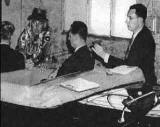 The Worshipful Master of the Laws of Physics The Worshipful Master of the Laws of Physics
 Click here to view media stream
Click here to view media stream |
Specter's Bloody Hands
"...He says maybe you shot too fast because I know they didn't want a shot coming from the front...they tried to put everything from the back side."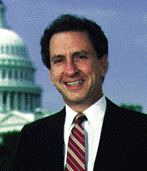
James E. Files, commenting on Charles Nicolletti's criticism of the hit on Kennedy
The Worshipful Master of the Laws of Physics? Sen. Arlan Specter, above, a freemason, Pa. Coppe Mitchell Lodge No. 605, now Scottish Rite. Suppressed all evidence of multiple shooters that would challenge the Warren Commission, Specter remains the fiercest proponent of the long discredited magic bullet theory which insists on the trajectory of a shooter from the "back side." To this end, Specter has labored tirelessly to suppress physical evidence and the testimony of key witnesses who handled the body and challenged the Lone Gunman Theory by contradicting Specter's insulting assertion of an impossible exit wound. |
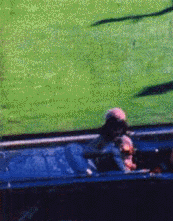 |
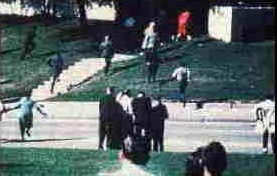
 The Zapruder Film
The Zapruder Film |
The Arrogance of Specter
If Specter Didn't See it, it Didn't Happen?
Witnesses running up and towards the wisps of smoke in the Grassy Knoll-- not away from it, not towards the Book Depository. |
|

Specter's Magic Bullet Defies Physics
LEFT: In this diagram from the the Clay Shaw trial, aside from the impossible trajectory of the bullet was the condition of the pristine "stretcher bullet" which was perfectly unmarked; unlike any bullet that would have shattered or warped when striking bone.
BOTTOM LEFT: Here is the bullet that killed Martin Luther King, Jr. This bullet struck only one man and obeyed the laws of physics. Does it look pristine? |
|
Efforts to Destroy Evidence Challenging Specter's Theory
 The windshield to Kennedy's limousine is a case in point. The angle of the hole in th The windshield to Kennedy's limousine is a case in point. The angle of the hole in th is windshield could only have come from the front of the vehicle. A shot that hit the metal frame frame atop the windshield. At least four shots were fired that missed the president and governor. During the Johnson administration, the limo's windshield was stored in the White House basement. Any evidence pointing to someone other than the patsy, Lee Harvey Oswald, would have insured the collapse of the coup, and the immediate scrutiny of ringleader Johnson, conspirators Hoover and former CIA Director Allen Dulles. is windshield could only have come from the front of the vehicle. A shot that hit the metal frame frame atop the windshield. At least four shots were fired that missed the president and governor. During the Johnson administration, the limo's windshield was stored in the White House basement. Any evidence pointing to someone other than the patsy, Lee Harvey Oswald, would have insured the collapse of the coup, and the immediate scrutiny of ringleader Johnson, conspirators Hoover and former CIA Director Allen Dulles.
| |
The Sick Obsession with the
"Lone Gunman" Theory
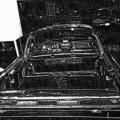 Even as President Kennedy's limo sat in Parkland Memorial Hospital, Johnson ordered the Secret Service and FBI agents to wash out the vehicle, destroying critical evidence of multiple gunmen; particularly bullet slivers and slugs from rifles other than Oswald's alleged weapon. Even bullet holes in the chassis which betrayed tell-tale impossible trajectories to fit the Lone Gunman were repaneled and refurbished at Johnson's orders. Even as President Kennedy's limo sat in Parkland Memorial Hospital, Johnson ordered the Secret Service and FBI agents to wash out the vehicle, destroying critical evidence of multiple gunmen; particularly bullet slivers and slugs from rifles other than Oswald's alleged weapon. Even bullet holes in the chassis which betrayed tell-tale impossible trajectories to fit the Lone Gunman were repaneled and refurbished at Johnson's orders.
Some who were allegedly provided false credentials by Johnson himself, who was in charge of security that day in Dallas. This criminal evidence tampering, which would have led to the immediate arrest of any other suspect in a similar situation, was dutifully ignored by the Warren Commission.
|
Kennedy's Missing Brain
The whereabouts of Kennedy's brain remain a mystery, and it's a shame too, because not only did it hold bullet fragments, it conclusively proved trajectory. It was last seen in a steel bucket, preserved in a formaldehyde solution in Admiral Calvin Galloway' cabinet in Bethesda Hospital, Maryland. This was critical evidence, because it not only verified the trajectory of the fatal head shot, but through bullet slivers which were found in the first set of x-rays taken in Parkland Memorial Hospital, proved more than one weapon was used. At leasttwo bullet fragments in Kennedy's face betrayed the presence of mercury loaded ammunition, traces of which were found on brain tissue in what are now missing slides.
|
|
|
|
Mac Wallace, a Johnson Crony and Hitman in the Sniper's Nest |
|
 According to the Warren Report t, there was a single fingerprint lifted from the carton designated "A" in the "sniper's nest" which could not be linked with Oswald, any other employee of the Texas School Book Depository, or any law enforcement officer that had handled the carton. The fingerprint remains in the National Archives, labeled "Unknown." According to the Warren Report t, there was a single fingerprint lifted from the carton designated "A" in the "sniper's nest" which could not be linked with Oswald, any other employee of the Texas School Book Depository, or any law enforcement officer that had handled the carton. The fingerprint remains in the National Archives, labeled "Unknown."
However, by 1998, a 14 point match with Malcolm Wallace's prints would be made, thereby directly linking Johnson to the assassination. (Wallace's prints were, of course, on record after his conviction.) On March 9, 1998, A. Nathan Darby, A.L.C.E., a Certified Latent Fingerprint Examiner, and a member of the International Association for Identification, signed a sworn affidavit stating that he found a positive match between the "Unknown" print from Carton "A" and the 1951 print of Mac Wallace.
For easier comparison, the "Unknown' print from the sniper's nest on the right has been duplicated and superimposed in red over the Wallace print on the left. The match becomes obvious even to the layman.
|
 Concealing the Throat Wound Concealing the Throat Wound | |
 |
Dr. Malcom Perry, one of Kennedy's attending surgeons at Parkland Memortial Hospital, noted there "was an entrance wound below his Adam's apple." Later, the Warren Commission, faced with yet more evidence of multiple shooters, would attempt to deny this entrance wound existed, offering the implausible contention that it was a tracheotomy....on a man that was dead on arrival. Indeed, there was no swelling or discoloration on Kennedy's face, indicating he died instantly.
| |
James E. Files
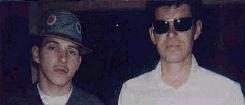 J J ames E. Files and J.D. Tippet's alleged assassin (in shades).
"...He says maybe you shot too fast because I know they didn't want a shot coming from the front...they tried to put everything from the back side."
James E. Files, commenting on
Charles Nicolletti's criticism of the hit on Kennedy
"The shell casing that I fired at John Kennedy, when I took it out of the weapon, It's one of those moments when you feel like you're above everything else and I guess I was a little bit cocky with it all. I took the casing and I put it in my mouth whole I put another casing - cartridge - into that one. Before putting it into the case and as I started to leave, I took the casing and I bit down on the casing to leave teethmarks on it and I set the casing, as a symbol, right on top of the stockade fence which I know I should have never done but I did that. Over the years, through other people, I have left certain trademarks along the way..... I left it more or less as a signature of my calling card."
James E. Files, in Robert G. Vernon Interview Transcript
| |
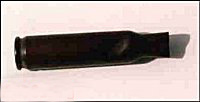 The Bullet Casing The Bullet Casing
Dented .222 casing found near wooden stockade fence in 1987 by John Rademacher. The dents were later verified to be human teeth marks Dr. Paul G. Stimson, a forensic odontologist at the University of Texas in Houston.
 "I shot a .222 with a mercury load in it. We used a mercury load...the .222 was designed to fragmentate...whoever you hit at...if you've got any type of bone structure, the round would fragmentate and explode and the round would be traveling at approximately about 3100 feet per second...which meant you would get penetration and explosion...." "I shot a .222 with a mercury load in it. We used a mercury load...the .222 was designed to fragmentate...whoever you hit at...if you've got any type of bone structure, the round would fragmentate and explode and the round would be traveling at approximately about 3100 feet per second...which meant you would get penetration and explosion...."
James. E. Files, confessed assassin of John F. Kennedy, in taped interview with
Robert G. Vernon
*Charles Nicoletti was shot in the head three times while in his car, which was set on fire on March 27, 1977. Sam Giancana and John Roselli also died violent death before being able to testify before House committees regarding the attempts on Fidel Castro's life and the assassination of John F. Kennedy. On July 19, 1975, Sam Giancana was found shot to death five days prior to his appearance before the Church Committee. In August of 1976, John Roselli would be found with his legs sawed off, and stuffed in a 55 gallon oil drum. His last meeting was with one of the conspirators he named in the Kennedy assassination-- Santos Trafficante. Trafficante worked directly with then-CIA Director Allen Dulles, John Rosselli, and Sam Giancana in the CIA/Mafia attempts to kill Castro. |
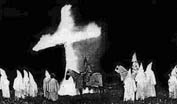
A Ku Klux Klan leader Headed the Murder Investigation of a Catholic President
As early as October 25th, 1965, the FBI was in possession of documents noting that
"Chief Justice [Earl] Warren
was the leader of a small local Klan group for several years..." Days before the murder, the FBI received word that a plot to kill Kennedy in Dallas involved elements of the Ku Klux Klan. In 1963, at least two Supreme Court justices had ties to the Klan (i.e., Warren and Hugo Black) |
|
The Body
This eyewitness account came almost a century before Baker's coded journals were ever discovered, and matched Baker's confession almost word for word. Likewise, in the Kennedy assassination it can be easily demonstrated that dozens were involved-- most of them trusted officials from both parties; and chillingly, the Supreme Court's Chief Justice, Earl Warren. In 1865, Andrew Johnson was not trusted by the president; in fact, actually avoided. During his term, the vice-president only had two meetings with President Lincoln after taking his oath of office in a disgraceful ceremony that smeared the entire Lincoln presidency. Andrew Johnson was totally drunk at the time he was sworn in, and it took years for the Lincoln administration to live it down.
Likewise, Lyndon Johnson was scarcely trusted by Kennedy. LBJ attracted even worse scandals, and still complained that the Kennedy brothers kept him out of important Cabinet meetings; this when Johnson was undermining the Kennedy's war on the Mafia with his own connections to the underworld. In fact, a close friend of Johnson, Billy Sol Estes, would come to testify before a Texas grand jury that vice-president Johnson was directly involved in the murder and cover-up of a U.S. Agricultural Agent. On June 3, 1961, Agent Henry Marshall was found shot to death in his car in Franklin, Texas. On June 8, 1961, a local Justice of the Peace declared Marshall had committed suicide, but found next to Agent Marshall was a single-action bolt action rifle which the local authorities had alleged he loaded, shot, reloaded and shot into his head five times.2
When he died, Agent Marshall was on the trail of a multi-million dollar swindle of the federal government's agricultural division. The scandal became known as the Billy Sol Estes Affair with LBJ a named conspirator by Estes himself, and moreover, Johnson's own personal legal counsel.
Johnson, Estes testified, had ordered Mac Wallace (pictured below) to do the hit.
A 14 Point Fingerprint Match Links Johnson
Malcom Wallace, in 1951, had already been convicted of murdering Doug Kinser. With Johnson's legal assistance, i.e. his personal attorney John Cofer, Wallace would walk away with a five year suspended sentence for murder...
According to the Warren Report t, there was a single fingerprint lifted from the carton designated "A" in the "sniper's nest" which could not be linked with Oswald, any other employee of the Texas School Book Depository, or any law enforcement officer that had handled the carton. The fingerprint remains in the National Archives, labeled "Unknown."
However, by 1998, a 14 point match with Malcolm Wallace's prints would be made, thereby directly linking Johnson to the assassination. (Wallace's prints were, of course, on record after his conviction.)
On March 9, 1998, A. Nathan Darby, A.L.C.E., a Certified Latent Fingerprint Examiner, and a member of the International Association for Identification, signed a sworn affidavit stating that he found a positive match between the "Unknown" print from Carton "A" and the 1951 print of Mac Wallace.
For easier comparison, the "Unknown' print from the sniper's nest on the right has been duplicated and superimposed in red over the Wallace print on the left. The match becomes obvious even to the layman.
Complicity of U.S. Navy
We now know a decoy ambulance was employed in the transport of Kennedy's body.4 The body was supposed to be in a black hearse, but it entered the Bethesda Naval Hospital through the rear entrance in an ambulance driven by Admiral Calvin Galloway, the man in charge at the hospital and an appointee of none other than Lyndon Johnson. Kennedy gave Johnson this special privilege to appoint the Secretary of the Navy to appease a monstrous ego. Indeed, Johnson once suggested the idea of a dual presidency, which Kennedy at first assumed was a joke. But Johnson was serious.
That unusual power given to Johnson meant the authority to control the whole navy itself. In terms of illicit deals with Mafia contractors, this could prove very profitable. One such contractor was the Pelican Tomato Company, an operation headed by a key figure in the JFK assassination: New Orleans Mafia don and Johnson associate, Carlos Marcello.
Throughout his years in the Senate, Marcello, via Johnson's Texas bagman Jack Halfin, gave some $50,000 a year to Johnson, and these contracts were one reason why.5 Around the time of the murder, Ruby and Ferrie both collected some $7,000 from Marcello.
Ferrie's library card would be found on Oswald upon his arrest for the murder of Officer J.D. Tippet and President Kennedy.
Ruby was also a friend of Chief Curry and Captain Fritz. (Chief Curry, in fact, was present when Johnson was sworn in as president on Air Force One.) Johnson's right to appoint the Secretary of the Navy actually plays a critical part in the assassination. This is how Johnson controlled high-level officers like Admiral Calvin Galloway even before the murder.
Like the Texas coroner in the Marshall case,
the Bethesda coroner, James Humes, would present a deliberately misleading autopsy to throw off honest investigators. Again we see the hand of Johnson.
By Texas law, the President's body could not be removed from Parkland Memorial Hospital until Dr. Earl Rose performed an autopsy. But before that could happen Johnson ordered that the body be immediately flown to Washington, where his own coroners would be in charge. The first priority-- make sure it would look like the work of a single gunman.
The Decoy Ambulance
When the First Lady arrived at the Bethesda Naval Hospital at about 6:55-7:05 p.m., November 22, 1963-- she arrived at the front of the building with a heavily guarded casket that was actually empty.
Another navy ambulance had arrived earlier, which was driven by a man in a white surgical smock. That driver was Admiral Galloway. It pulled up at the rear of the building, and a greyish-pink shipping casket was unloaded. In Dallas the president was tenderly wrapped in a white linen shroud and placed in a bronze ceremonial casket. By the time Kennedy's body arrived in Bethesda it was in a cheap shipping casket, and wrapped in a body bag. The final, cruelest indignity was that Kennedy was stripped naked and bereft of his shroud when they unzipped the bag.
You can imagine the surprise of the doctor falsely attributed with the original autopsy. At the Bethesda Naval Hospital, autopsy assistant Paul O'Conner could only describe Cmdr. James Joseph Humes as uncharcteristically "scared to death" when he unzipped the body bag, looked into Kennedy's skull, and he saw no brain. Naturally. The brain contained evidence of trajectory and bullet fragments.
"Moreover, we know the identities of several of the individuals who were involved in the cover-up. These persons could be subpoenaed and finally asked tough, probing questions about their disgraceful behavior--and, if caught lying under oath, could be prosecuted for perjury. Who are these individuals? In my opinion, the list includes former WC counsels
Arlen Specter and Wesley Liebeler, the three autopsy doctors, certain active and retired FBI agents and CIA officers, and former Dallas police lieutenant J. C. Day."
From Preface; "More than a Reasonable Doubt" by Michael Griffith
* Audrey Bell, a nursing supervisor at Parkland Hospital.
* Diana Bowron, Parkland Hospital nurse. Nurse Bowron actually cleaned the large defect and packed it with gauze squares in preparing the body for the casket. She vividly remembers that the large head wound was in the right rear part of the skull.
* Dr. Kemp Clark, Parkland Hospital.
* Dr. Charles Crenshaw, Parkland Hospital.
* Jerrol Custer, the x-ray technician at Bethesda Hospital who took the President's autopsy x-rays.
* Dr. Richard Dulaney, Parkland Hospital.
* Dr. John Ebersole, Bethesda Hospital radiologist. In an extensive interview with his hometown newspaper in 1978, Dr. Ebersole said, "When the body was removed from the casket there was a very obvious horrible gaping wound in the back of the head"
(18:543).
* William Greer, Secret Service agent, who drove the presidential limousine.
* Clint Hill, a Secret Service agent who was taken to the morgue for the express purpose of viewing the President's wounds and who was also in the Parkland trauma room when the President was being treated. It was Agent Hill who climbed onto the back of the limousine to get Jackie Kennedy to return to her seat. Hill testified that as he was lying over the top of the back seat "I noticed a portion of the President's head on the right rear side was missing and he was bleeding profusely" (8:285, emphasis added).
* Patricia Hutton (now Patricia Gustaffson), a nurse at Parkland Hospital who placed a bandage against the wound in the back of the head.
* James Curtis Jenkins, a Navy lab technician at Bethesda Hospital who was present at the autopsy.
* Dr. Robert Karnei, Bethesda Hospital, who was present at the autopsy.
* Roy Kellerman, a Secret Service agent who was present at the autopsy.
* Dr. Robert McClelland, Parkland Hospital.
* Doris Nelson, a chief nurse at Parkland Hospital.
* Floyd Riebe, a photographic technician who took pictures of the President's body at Bethesda Hospital.
* Aubrey Rike, an ambulance driver and funeral home worker in Dallas. Rike was called to Parkland Hospital soon after the shooting and assisted in placing the President's body in the casket. Rike could actually feel the edges of the large wound in the back of the head.
* Tom Robinson, the mortician who had the job of putting the President back together after the autopsy in case the family wanted to take one last look at him. Robinson, of course, had to spend a good part of his time handling the President's head. He saw and felt the large wound in the back.
* Jan Gail Rudnicki, a lab assistant at Bethesda Hospital who was present at the autopsy.
* Roy Stamps, a Fort Worth newsman who saw Kennedy lying in the limousine before he was moved into Parkland Hospital. Said Stamps, "I rushed up and saw Kennedy lying in the car.... The back of his head was gone" (5:362, emphasis added).
* Dr. David Stewart, Parkland Hospital.
*MICHAEL T. GRIFFITH is a two-time graduate of the Defense Language Institute in Monterey, California, and of the U.S. Air Force Technical Training School in San Angelo, Texas. His articles on the JFK assassination have appeared in Dateline: Dallas and in Dallas '63. Mr. Griffith lives and works in England and is an employee of the United States Department of Defense. He has a top secret security clearance. The views he expresses are his own personal views and are not the views of the United States Department of Defense.
**Assassination Records Review Board:
Honorable John R. Tunheim, Chair; U.S. District Court Judge, District of Minnesota.
Dr. Henry F. Graff; Professor Emeritus of History at Columbia University.
Dr. Kermit L. Hall; Dean, College of Humanities, and Professor of History at The Ohio State University.
Dr. William L. Joyce; Associate University Librarian for Rare Books and Special Collections at Princeton University.
Dr. Anna K. Nelson; Distinguished Adjunct Historian in Residence at The American Univers> **Assassination Records Review Board:
Honorable John R. Tunheim, Chair; U.S. District Court Judge, District of Minnesota.
Dr. Henry F. Graff; Professor Emeritus of History at Columbia University.
Dr. Kermit L. Hall; Dean, College of Humanities, and Professor of History at The Ohio State University.
Dr. William L. Joyce; Associate University Librarian for Rare Books and Special Collections at Princeton University.
Dr. Anna K. Nelson; Distinguished Adjunct Historian in Residence at The American University.
| Newly
released JFK documents raise questions about medical evidence
By DEB RIECHMANN
Associated Press Writer
WASHINGTON (AP) --
The latest batch of John F. Kennedy assassination documents raises new questions
about an examination of the president's brain and lays out unresolved
discrepancies in other medical evidence.
The
more than 400,000 pages of records being made public at the National
Archives today were compiled in the past four years by the
Assassination Records Review Board, an independent panel that
Congress set up to collect and release material related to Kennedy's
death in Dallas on Nov. 22, 1963.
Congress did not direct the review board to reinvestigate the
assassination, and the panel issued no formal opinions on any aspect
of the controversial murder. But in the board's effort to expand and
clarify the record, details surfaced that:
- Suggest two different brain exams may have been conducted at the
Bethesda, Md., Naval Medical Center, raising questions about the
authenticity of the brain examined.
- Fail to resolve discrepancies between how physicians at Parkland
Hospital in Dallas described Kennedy's head injury immediately
following the shooting and how it was subsequently
described by pathologists at Bethesda.
Although the Warren Commission concluded that Kennedy was shot from
behind by a single gunman, how Kennedy was assassinated and from
what direction he was shot have nonetheless been hotly debated for
35 years. The review board studied old testimony and medical
evidence and re-interviewed witnesses, but still was unable to
resolve certain issues.
"There are questions about the supplemental brain exam and the
photos that were taken. There are inconsistencies in the
testimony of the autopsy doctors about when that exam took place,"
said Jeremy Gunn, executive director and general counsel of the
board, which closed out its work in September. "These are serious
issues. The records are now out there for the public to evaluate."
Three military pathologists agree they conducted an autopsy of
Kennedy's entire body at Bethesda immediately after it was flown
back from Dallas. But the doctors offer conflicting recollections
about the timing of a subsequent brain exam.
Two
doctors, J. Thornton Boswell and James Humes,
told the review board that the brain exam occurred two or three days
after Kennedy's death. Initially, Humes told the Warren Commission
that he, Boswell and a third pathologist, Dr. Pierre Finck,
were present when the brain was examined. But when he testified to
the review board in 1996, Humes did not list Finck among those
present. Boswell maintains Finck was not there.
 |
| LEFT
to Right: James Humes, Thorton Boswell, Pierre Finck. |
On the
other hand, Finck says the brain exam did not occur until much
later. In a memo he wrote to his commanding officer 14 months after
Kennedy was assassinated, Finck said Humes did not call him until
Nov. 29, 1963 -- seven days after Kennedy's death -- to say it was
time to examine the brain. In the memo, Finck said all three
pathologists examined the brain together and that "color and
black-and-white photographs are taken by the U.S. Navy
photographer."
The conflicting testimony caused Douglas Horne,
chief analyst for military records, to conclude in a 32-page
memo that two separate brain exams may have been conducted,
"contrary to the official record as it has been presented to the
American people." "If true, Dr. Finck's account of a brain exam
separate and distinct from the first one would mean that Drs.
Humes and Boswell were present at two different brain exams," he
writes.
Humes was ill and could not be interviewed. In a telephone
interview, Boswell reiterated that the brain was examined at the
initial autopsy of the body and only once more at a separate brain
exam a few day later.
"I
doubt very much that we would have called him (Finck) back over for
that," Boswell said. Boswell added that the only photos of the
brain were taken at the autopsy.
This
conflicts with testimony the board obtained from Navy photographer
John Stringer, who said he took pictures of the brain two or three
days after the autopsy. Stringer also
testified that official photos of the brain preserved at the
archives do not match those he remembers taking. He cites
discrepancies in the angles from which they were shot and the type
of film used.
In
addition, former FBI Agent Francis O'Neill Jr., who watched doctors
remove Kennedy's brain the night he died, told the review board that
the archives' photos do not resemble what he saw. "I did not recall
it (the brain) being that large," O'Neill said.
Throughout the years, doctors who treated Kennedy in Dallas said his
head wound was about the size of a large egg at the back of
the head, behind his right ear. The Dallas doctors told reporters
then that they believed Kennedy was shot from the front -- a belief
that conflicted with the Warren Commission's later conclusion of a
single shooter firing from behind.
Humes, chief pathologist for the autopsy at
Bethesda, agreed there was a wound to the right rear of
Kennedy's head, but he told the board that it was a small entry
wound, not an egg-sized exit wound. In contrast to observations in
Dallas, Humes said there also was massive damage to the top of
Kennedy's skull and right side forward of the ear.
Copyright 1998 Associated Press
|
|
Up |
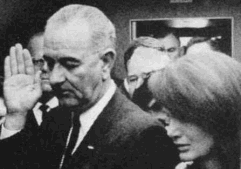

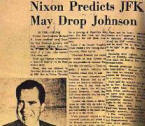






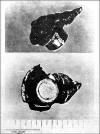









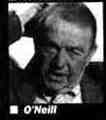
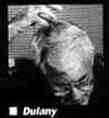
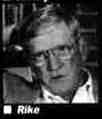

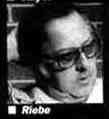


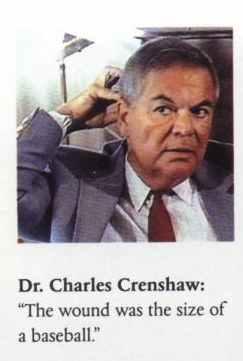
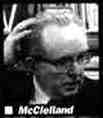
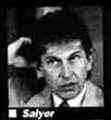


 According to the Warren Report t, there was a single fingerprint lifted from the carton designated "A" in the "sniper's nest" which could not be linked with Oswald, any other employee of the Texas School Book Depository, or any law enforcement officer that had handled the carton. The fingerprint remains in the National Archives, labeled "Unknown."
According to the Warren Report t, there was a single fingerprint lifted from the carton designated "A" in the "sniper's nest" which could not be linked with Oswald, any other employee of the Texas School Book Depository, or any law enforcement officer that had handled the carton. The fingerprint remains in the National Archives, labeled "Unknown."

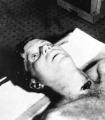

 The Bullet Casing
The Bullet Casing

